EXCLUSIVE ARTICLE |
||
|
||
EXCLUSIVE ARTICLE |
||
|
||
 |
||||||
|
“See The World's
Greatest Villains...” |
||||||
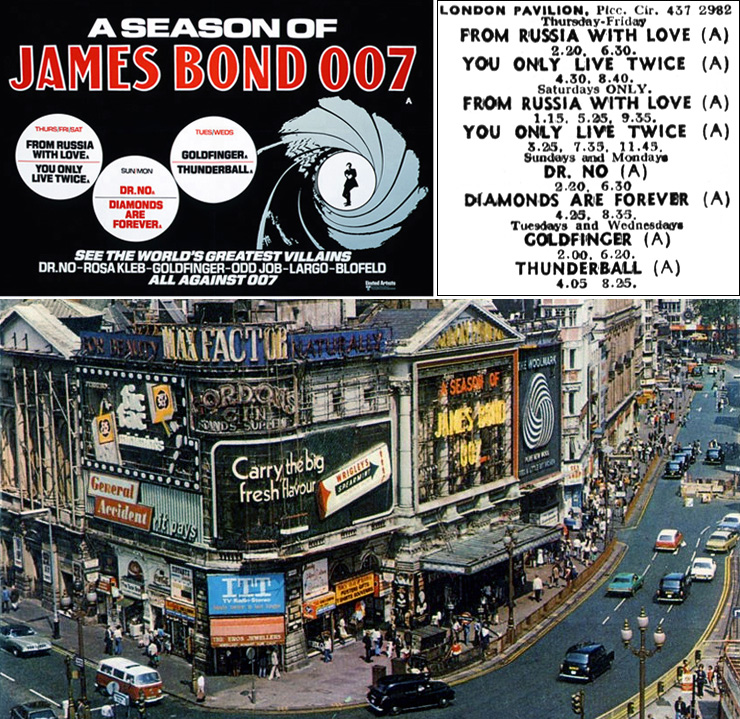 |
||||||
|
The season also played across the country where the pairings of films were different to the London release. Some cinemas screened a different film each on day of the week; whilst others also included On Her Majesty's Secret Service as part of the season. The National Screen Service produced a set of black & white Front of House stills (10" X 8") which were made available to cinema managers who booked the season from May through to the end of 1975. Dr. No was dropped from distribution once it had premiered on UK TV and was replaced with Live And Let Die. |
||||||
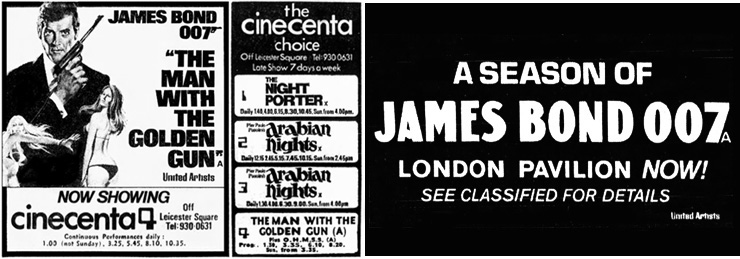 |
||||||
|
The week before the James Bond season opened at the London Pavilion, the Cinecenta Panton Street, just off Leicester Square and Haymarket, was showing The Man With The Golden Gun on the 145-seat Screen 4 Thursday May 8, 1975, but on Friday 16th it was joined by On Her Majesty's Secret Service. One assumes that the enterprising manager of the Cinecenta paired these two films to complement the Sean Connery season at the London Pavilion. The Man With The Golden Gun/On Her Majesty's Secret Service then played for a further six days until Wednesday May 21, 1975. |
||||||
 |
||||||
|
||||||
|
The James Bond films were then absent from London's West end for most of 1976. From Russia With Love was shown for the first time on UK television, and ranked number one in the weeks TV ratings. Goldfinger then premiered on the ITV network on November 3, 1976, again topping the ratings for that week; with From Russia With Love broadcast again on December 28, just seven months after it TV premiere. |
||||||
|
“Moore and Connery -
Together at last...” |
||||||
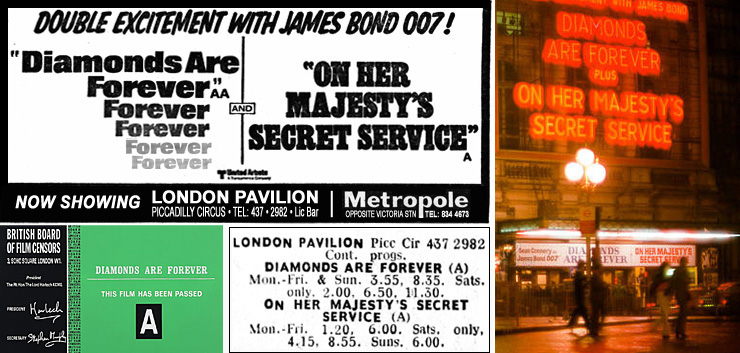 |
||||||
|
Diamonds Are Forever therefore returned to the London Pavilion on a double-bill with On Her Majesty’s Secret Service for three weeks commencing Thursday October 21, 1976. The double-bill played concurrently at the 2,000-seat Metropole cinema opposite Victoria Station, but would not be released provincially until early 1978. |
||||||
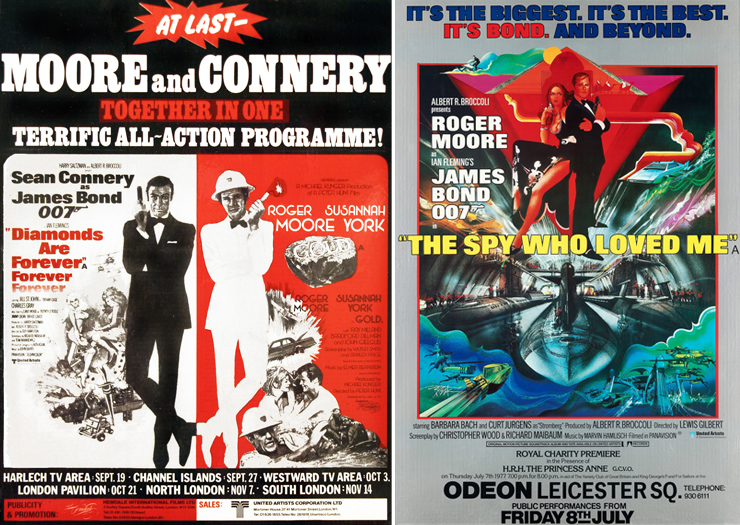 |
||||||
|
“It's The Biggest.
It's The Best. It's Bond. And Beyond” |
||||||
|
||||||
|
The Spy Who Loved Me had its press screening at the ODEON Leicester Square on the morning of Tuesday July 5, 1977; followed by its World Premiere at the same cinema on the evening of Thursday July 7, 1977. The Royal Charity Premiere was held in the presence of Her Royal Highness The Princess Anne, accompanied by her great-uncle Lord Louis Mountbatten (1900-1979). Attending the Premiere were Roger Moore, Barbara Bach, Curt Jurgens, Richard Kiel, Desmond Llewelyn, Walter Gotell, Caroline Munro, Sydney Tafler, editor John Glen and Director Lewis Gilbert. Producer ‘Cubby’ Broccoli also attended with wife Dana and daughter Barbara. Among the other celebrities invited to the premiere were director Bryan Forbes with his actress wife Nanette Newman. Michael Caine (and his wife Shakira) also attended, and was reunited with Alfie (1966) director Lewis Gilbert. Flamboyant actor/wrestler Milton Reid [who played Jaws’ sidekick Sandor in The Spy Who Loved Me] turned heads when he arrived at the ODEON accompanied by English glamour model & adult film star Mary Millington (1945-1979). Reid had first appeared as one of the Joseph Wiseman's guards in Dr. No (1962), and two years later unsuccessfully publicly lobbied for the part of Oddjob in Goldfinger (1964). Also attending were Hammer Films co-founder Sir James Carreras, and The Spy Who Loved Me Co-Screenwriter Christopher Wood. At the after-screening party held at the PLAYBOY Club on Park Lane, the main cast members and producer were presented with gold-plated editions of CORGI's Lotus Esprit by designer Marcel van Cleemput. The Spy Who Loved Me broke the house record at the ODEON Leicester Square, taking a staggering £57,625 in its first seven days and continued to play at the flagship venue until September 15, 1977. |
||||||
|
||||||
|
For the first two
weeks of September 1977 The Spy Who Loved Me was playing
simultaneously at the ODEON Leicester Square, ODEON Kensington, London Pavilion and the
2,172-seat Dominion Theatre, Tottenham Court Road. The Spy Who Loved
Me continued to play at the Dominion until Saturday December 17,
1977; and at the
Pavilion until Wednesday February 25, 1978. |
||||||
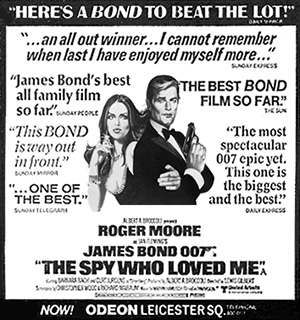 |
||||||
|
As television continued to make a significant impact on cinema attendance Rank saw this as a way of enticing cinemagoers by offering more choice and allowing popular films to be retained on a smaller screen to meet demand. This was exactly what happened in 1977 when The Spy Who Loved Me opened at the ODEON Kensington on Thursday August 18th, and played on the 665-seat Screen One for three weeks and also concurrently on the smaller Screen Three for its fourth week from Thursday September 8, 1977. This was followed by another two weeks in Screen One from Thursday September 15, 1977, before transferring to the 200-seat Screen Two and 300-seat Screen Three from Thursday September 29th to make way for United Artists’ other 1977 big hit A Bridge Too Far. The Spy Who Loved Me played for one week on the smaller screens and a further week just on Screen Three from Thursday October 6, 1977. Then after a two-week break The Spy Who Loved Me returned to the ODEON Kensington to play for another four weeks on Screen One from Thursday October 27, 1977, followed by another six weeks on Screen Two from Thursday November 24th. Such was the popularity of Roger Moore's fourth 007 adventure that The Spy Who Loved Me spent a total of 18 weeks at the ODEON Kensington from August 1977 to January 1978 - a pattern that was repeated across the UK and Ireland with the film playing for 17 weeks in Liverpool, Dublin and Glasgow where it became the most popular film ever shown at the ODEON. The Spy Who Loved Me was the first James Bond film not to have custom made artwork featured on the large neon exterior of the London Pavilion [pictured below right]. By 1978 all films playing at the venue were only advertised on the exterior canopy and street-level facade of the building, and this would remain the case until the London Pavilion ceased operation as a cinema in April 1981 (although its exterior would still be used to advertise upcoming United Artists releases). |
||||||
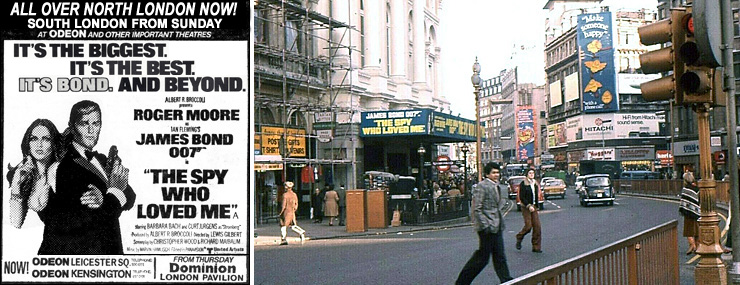 |
||||||
|
||||||
|
Opened in 1938 as The Topical News Theatre, the venue originally had one 306-seat auditorium which showed newsreels, and was the only cinema to be built inside a London Underground railway station. The Spy Who Loved Me also played for three weeks at the 160-seat FilmCenta 2, Charing Cross Road from Thursday March 2, 1978. Originally opened as Pyke’s Cambridge Circus Cinematograph Theatre in 1911 with stalls and circle seating, the 690-seat venue was converted and re-opened at Filmcenta 1-2-3 on February 17, 1977. |
||||||
 |
||||||
|
“007 X 2 = A licence
To Thrill!” |
||||||
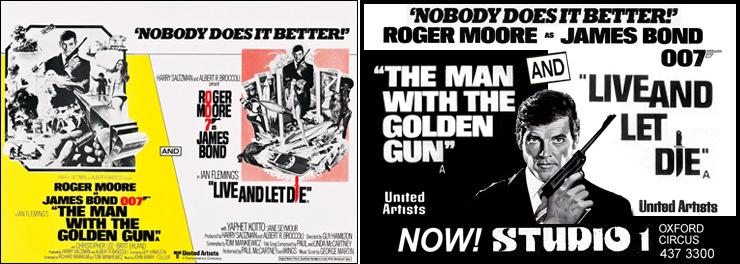 |
||||||
|
Live And Let Die was released once again at the London Pavilion on a double-bill with The Spy Who Loved Me for four weeks from Thursday February 1, 1979, and again for another four weeks from Thursday March 8th at the Gala Royal, Marble Arch. The pair also played across the country in the months leading up to the release of Moonraker (1979). |
||||||
 |
||||||
|
Unusually the quad-crown poster [pictured below] bore the credit “Ian Fleming's The Spy Who Loved Me”, and was the only advertising for the film ever to do so. Since the film was first released in July 1977, all advertising materials bore the revised credit “Albert R. Broccoli presents Roger Moore as Ian Fleming's James Bond 007 in...”. Even the tri-folded (14" X 9") sheet advertising the various sizes of composite materials available to newspapers showed a mock-up of the poster with the correct credit! |
||||||
|
||||||
|
“Outer space now belongs to 007” |
||||||
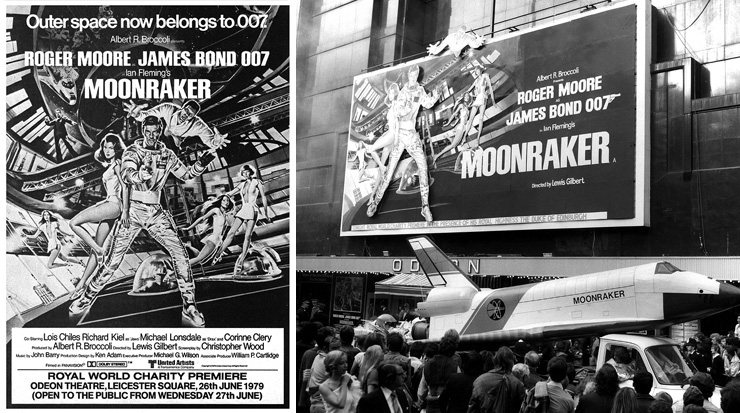 |
||||||
|
Also attending the Moonraker premiere was Bernard Lee [pictured below right with his second wife Ursula] who had played M in every Bond film since 1962. Lee later attempted to shoot his scenes on For Your Eyes Only with Lois Maxwell in November 1980, but it was evident he was too ill to continue. The 73 year-old actor died on January 16, 1981. Out of respect for the late actor, Producer Albert R. Broccoli refused to recast the role in For Your Eyes Only (1981) and his lines were given to the character of Chief-of-Staff Tanner [played by English character actor James Villiers (1933-1998)], who explained that M was ‘on leave’. The role of M was then played by in the next four films in the series by Robert Brown (1921-2003), who had earlier appeared as Admiral Hargreaves in The Spy Who Loved Me (1977). Bernard Lee's portrait is seen in the Scottish castle headquarters of MI6 in The World Is Not Enough (1999); with Robert Brown's portrait making an appearance (along with that of Judi Dench) in the office of current M Ralph Fiennes in No Time To Die (2021). Bernard Lee's portrait was also on set but ultimately omitted from the final edit. All three portraits were on display in the OMEGA store in London's Burlington Arcade in September 2021, as part of a 007 themed installation celebrating the release of the 25th James Bond film. |
||||||
|
||||||
|
||||||
|
Moonraker finished its 20-week run at the ODEON Marble Arch on Wednesday December 12, 1979. Moonraker also played at the ODEON Kensington from Thursday August 16th; playing in Screen One for three weeks, and then transferring to Screen Two for a further three weeks, ending its engagement as the first film to play on the newly opened Screen Four for two weeks from Thursday September 27, 1979. |
||||||
 |
||||||
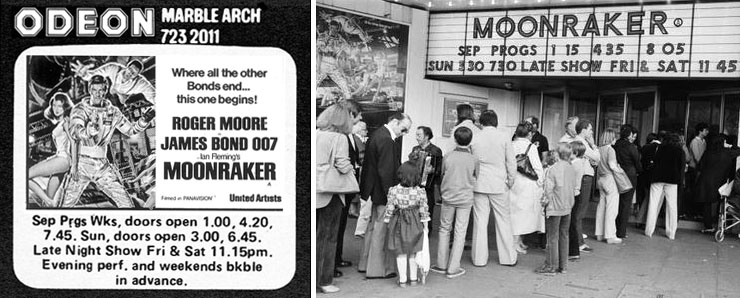 |
||||||
|
Moonraker played at the London Pavilion for 18-weeks until Wednesday January 9, 1980; and then transferred to the smaller 222-seat Classic 3 Haymarket, where it played for three weeks until Wednesday January 30th. Moonraker had therefore played continuously in London’s West End for an astonishing seven months! |
||||||
 |
||||||
|
“James Bond on the
South Bank” |
||||||
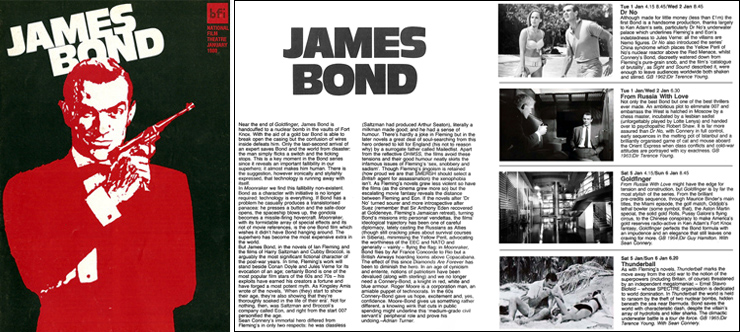 |
||||||
|
The season continued at 4.15pm on Saturday January 5, 1980, with a triple-bill of Goldfinger, Thunderball and You Only Live Twice. The trio screened again on Sunday 6th January this time in reverse order. A week later another triple-bill of On Her Majesty's Secret Service, Diamonds Are Forever and Live And Let Die began at 3.45pm in NFT1, and was repeated on Sunday January 13th, again in reverse order. The final triple-bill of The Man With The Golden Gun, The Spy Who Loved Me and Moonraker played in NFT1 from 3.45 on Saturday January 19, 1980, with the films in reverse order on Sunday 20th. Coincidentally this day also saw the UK television premiere of Live And Let Die on the ITV network, when the film was viewed by a staggering 23.50 million viewers (which was almost half of the entire population). Roger Moore's debut film as 007 still holds the record as the most-viewed film ever screened on UK television - an achievement likely never to be surpassed! |
||||||
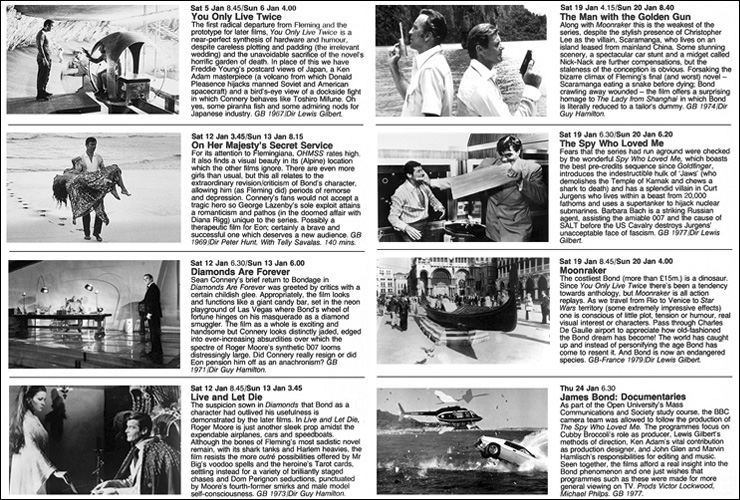 |
||||||
|
In the programme notes Adrian Turner incorrectly stated that Goldfinger's main titles were designed by Maurice Binder, and commented that On Her Majesty's Secret Service was “Possibly a therapeutic film for EON; certainly a brave and successful one which deserves a new audience”. Although the film had not been seen on the big screen for several years, it was greeted with rapturous applause by the sell-out audience. The season concluded in
NFT1 on Thursday January 24, 1980, with a screening of several episodes
from the 8-part 1977 Open University series focussing on the making of
The Spy Who Loved Me. The documentaries were made as study material
for the Open University course Mass Communication and Society, and
originally screened every two-weeks in the early hours of the morning on BBC2 from July -
October 1977. The series was repeated annually for six years on BBC
Television, and remains one of the most in-depth insights into the making
of a James Bond film ever produced. The full 184-minute series is available in poor quality on
Youtube, and one episode was released as an extra on the original
US MGM DVD of The Spy Who Loved Me in 1998. |
||||||
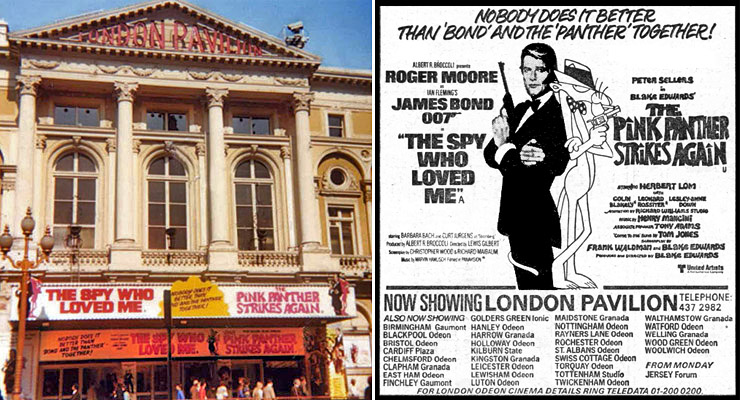 |
||||||
|
The James Bond films had been successfully paired with others from different franchises or genres for provincial releases throughout the 1960s and 1970s, so the 007/Pink Panther combination was not as unusual as one might initially expect. Peter Sellers had of course starred in the 1967 version of Casino Royale playing one of the many mock James Bonds, and even filmed a spoof gun barrel sequence used as the teaser trailer for the next film in the series, Revenge Of The Pink Panther (1978). A two-colour quad-crown poster was created for the release using a slightly altered version of Bob Peak's artwork from the original The Spy Who Loved Me poster in reverse. The unlikely double-bill was also very successful outside London, initially playing during the Easter school holidays. |
||||||
|
||||||
|
The London Pavilion once again played host to the latest Bond double-bill of Moonraker/The Man With The Golden Gun for two weeks from Thursday July 3, 1980. For the first week the double-bill was also playing concurrently at the ODEON Kensington on the 665-seat Screen One. The pair were still screening in London and provincially until November – only a month before the UK TV premiere of The Man With The Golden Gun on Christmas Day. |
||||||
 |
||||||
 |
||||||
|
|
||||||